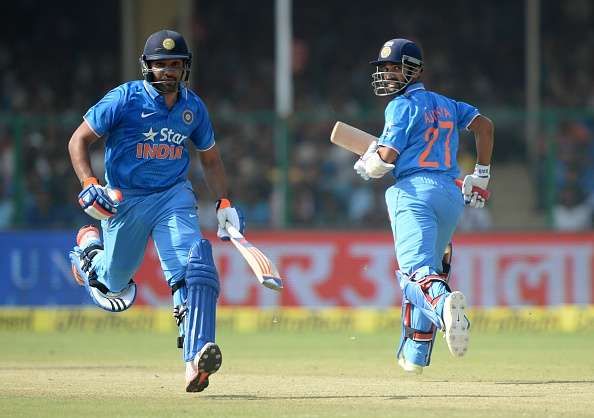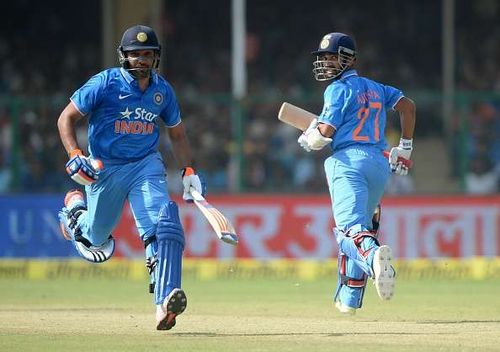
Why Ajinkya Rahane should open for India in ODIs
Prodigious talents in India start off early but sometimes lose their way in the glam and glitz that surrounds the game these days. Ajinkya Rahane is a pleasant anomaly to that trend, a silent, diminutive figure who goes about his business earnestly.
Part of India’s U-19 setup in 2007, he blasted twin hundreds when the team toured New Zealand, in a tournament that consisted of players like Virat Kohli and Kane Williamson. He rose up the ranks and made his first class debut for Mumbai as a 19-year old, and his performance was instrumental in his team winning the Ranji trophy in 2008-09.
Having debuted for the national side in 2011, he was asked to open along with Parthiv Patel at Chester-Le-Street against an English attack, part of which had annihilated India’s test line-up just the previous month. He made a composed 44-ball 40 in that game, and played second-fiddle to Patel, who fell just five short of his first ODI ton. In a 3-0 drubbing of the Indian team, Rahane impressed one and all with his intent during the powerplay. His batting was assured and conventional, but he was adept at finding gaps and play over the in-field.
However, despite being selected in 2011, he stayed in the squad for 16 months, and saw as many as seven people get the Test cap ahead of him. He had to warm the benches till 2013, when he became the first player from Mumbai to make his Test debut since 2007. Till 2012, he wasn’t considered to be an ideal T20 player, but the 2012 season with the Rajasthan Royals gave him the platform to showcase the depth in his game.
Given his success at the top of the order for the Rising Pune Supergiants, it opens up a relevant question, should he open for India in ODIs too?
The current Indian opening pair, Rohit Sharma and Shikhar Dhawan, have no doubt been prolific at the top of the order. Sharma, on the back of two double tons, has broken a number of ODI batting records. He has constructed huge scores at the top by simplifying his approach to the game. He takes time to settle down, adjusting to the new ball, and hits the odd ball to the boundary with conventional strokes in the starting overs. Once he gets his eye in, he changes gears and adds a different dimension to his innings, mixing copybook shots with brazen innovation.
His partner, Shikhar Dhawan, made a remarkable debut in Tests, hitting a swashbuckling 187 against Australia at Mohali. In ODIs, he has stacked up nine centuries at an average of almost 44. Yet, off late, he hasn’t been consistent, falling to the same kind of strokes match after match. Before his 126 against Australia early this year, he kept getting out after putting up starts. This put added pressure on Sharma to perform. Kohli, with his copious amount of runs, coming in at 3, Dhawan’s performances weren’t under the scanner.
The difference that Ajinkya Rahane can create is provide more assurance and dependability at the top of the order. With a more poised approach upfront, the middle order gets more freedom to go for their strokes in the latter part of the innings. And given the T20 culture, it is not difficult to change gears if a good platform has already been laid.
The combination of Rohit and Rahane can provide India great starts in the initial overs. Both of them, given their gift for piercing gaps, can go for their conventional strokes when the field is up.
Rahane played only one ODI in 2012 and six in 2013. He has been shunted up and down the order, and has batted as far down as No.7, based on the team’s requirements. However, given his style of play, he has not been given enough deliveries to prove his worth. Both Rahane and Sharma need some time to get going, and can weather the new ball while they get their eye in. A Rahane in the middle order is not as effective, as he doesn’t go for his shots straight away.
Before becoming an opener, Rohit Sharma used to average 14 every inning, with a strike rate in the early 70s. If Rahane is given extends runs at the top of the order, he can be a valuable asset, as he has been in T20s for Rajasthan and Pune. His strike rate in this IPL and the previous one has been in the 130s, which is more than that of Shikhar Dhawan. This season, he has been the lone bright spot in a dismal Pune Supergiants campaign that has cracked under a spate of injuries to their star players. Indifferent form of his teammates has further put pressure on Rahane, but he has performed steadily, and has already notched up six half-centuries, the most by any batsman this season.
India’s next ODI series is against Zimbabwe, and gives the selectors ample space to try out new combinations. It remains to be seen whether the think-tank tinkers with the tried and tested pair.
